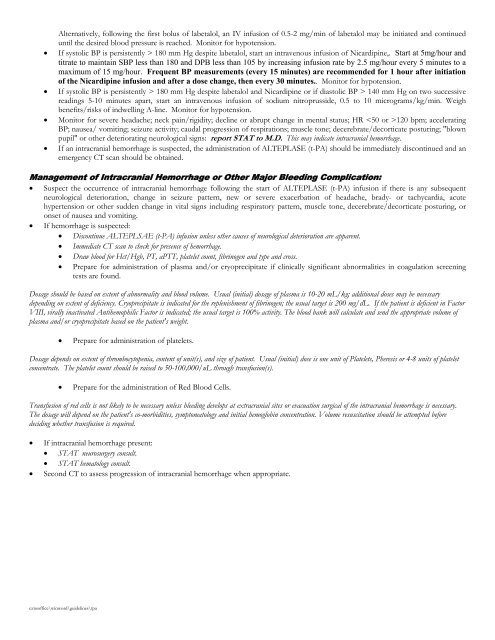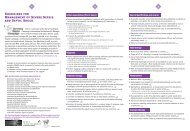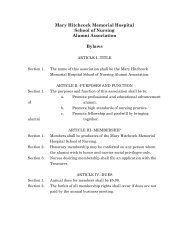Guideline for the Use of Intravenous ALTEPLASE (t-PA)
Guideline for the Use of Intravenous ALTEPLASE (t-PA)
Guideline for the Use of Intravenous ALTEPLASE (t-PA)
You also want an ePaper? Increase the reach of your titles
YUMPU automatically turns print PDFs into web optimized ePapers that Google loves.
Alternatively, following <strong>the</strong> first bolus <strong>of</strong> labetalol, an IV infusion <strong>of</strong> 0.5-2 mg/min <strong>of</strong> labetalol may be initiated and continueduntil <strong>the</strong> desired blood pressure is reached. Monitor <strong>for</strong> hypotension.• If systolic BP is persistently > 180 mm Hg despite labetalol, start an intravenous infusion <strong>of</strong> Nicardipine,. Start at 5mg/hour andtitrate to maintain SBP less than 180 and DPB less than 105 by increasing infusion rate by 2.5 mg/hour every 5 minutes to amaximum <strong>of</strong> 15 mg/hour. Frequent BP measurements (every 15 minutes) are recommended <strong>for</strong> 1 hour after initiation<strong>of</strong> <strong>the</strong> Nicardipine infusion and after a dose change, <strong>the</strong>n every 30 minutes.. Monitor <strong>for</strong> hypotension.• If systolic BP is persistently > 180 mm Hg despite labetalol and Nicardipine or if diastolic BP > 140 mm Hg on two successivereadings 5-10 minutes apart, start an intravenous infusion <strong>of</strong> sodium nitroprusside, 0.5 to 10 micrograms/kg/min. Weighbenefits/risks <strong>of</strong> indwelling A-line. Monitor <strong>for</strong> hypotension.• Monitor <strong>for</strong> severe headache; neck pain/rigidity; decline or abrupt change in mental status; HR 120 bpm; acceleratingBP; nausea/ vomiting; seizure activity; caudal progression <strong>of</strong> respirations; muscle tone; decerebrate/decorticate posturing; "blownpupil" or o<strong>the</strong>r deteriorating neurological signs: report STAT to M.D. This may indicate intracranial hemorrhage.• If an intracranial hemorrhage is suspected, <strong>the</strong> administration <strong>of</strong> <strong>ALTEPLASE</strong> (t-<strong>PA</strong>) should be immediately discontinued and anemergency CT scan should be obtained.Management <strong>of</strong> Intracranial Hemorrhage or O<strong>the</strong>r Major Bleeding Complication:• Suspect <strong>the</strong> occurrence <strong>of</strong> intracranial hemorrhage following <strong>the</strong> start <strong>of</strong> <strong>ALTEPLASE</strong> (t-<strong>PA</strong>) infusion if <strong>the</strong>re is any subsequentneurological deterioration, change in seizure pattern, new or severe exacerbation <strong>of</strong> headache, brady- or tachycardia, acutehypertension or o<strong>the</strong>r sudden change in vital signs including respiratory pattern, muscle tone, decerebrate/decorticate posturing, oronset <strong>of</strong> nausea and vomiting.• If hemorrhage is suspected:• Discontinue ALTEPLSAE (t-<strong>PA</strong>) infusion unless o<strong>the</strong>r causes <strong>of</strong> neurological deterioration are apparent.• Immediate CT scan to check <strong>for</strong> presence <strong>of</strong> hemorrhage.• Draw blood <strong>for</strong> Hct/Hgb, PT, aPTT, platelet count, fibrinogen and type and cross.• Prepare <strong>for</strong> administration <strong>of</strong> plasma and/or cryoprecipitate if clinically significant abnormalities in coagulation screeningtests are found.Dosage should be based on extent <strong>of</strong> abnormality and blood volume. Usual (initial) dosage <strong>of</strong> plasma is 10-20 mL/kg; additional doses may be necessarydepending on extent <strong>of</strong> deficiency. Cryoprecipitate is indicated <strong>for</strong> <strong>the</strong> replenishment <strong>of</strong> fibrinogen; <strong>the</strong> usual target is 200 mg/dL. If <strong>the</strong> patient is deficient in FactorVIII, virally inactivated Antihemophilic Factor is indicated; <strong>the</strong> usual target is 100% activity. The blood bank will calculate and send <strong>the</strong> appropriate volume <strong>of</strong>plasma and/or cryoprecipitate based on <strong>the</strong> patient's weight.• Prepare <strong>for</strong> administration <strong>of</strong> platelets.Dosage depends on extent <strong>of</strong> thrombocytopenia, content <strong>of</strong> unit(s), and size <strong>of</strong> patient. Usual (initial) dose is one unit <strong>of</strong> Platelets, Pheresis or 4-8 units <strong>of</strong> plateletconcentrate. The platelet count should be raised to 50-100,000/uL through transfusion(s).• Prepare <strong>for</strong> <strong>the</strong> administration <strong>of</strong> Red Blood Cells.Transfusion <strong>of</strong> red cells is not likely to be necessary unless bleeding develops at extracranial sites or evacuation surgical <strong>of</strong> <strong>the</strong> intracranial hemorrhage is necessary.The dosage will depend on <strong>the</strong> patient's co-morbidities, symptomatology and initial hemoglobin concentration. Volume resuscitation should be attempted be<strong>for</strong>edeciding whe<strong>the</strong>r transfusion is required.• If intracranial hemorrhage present:• STAT neurosurgery consult.• STAT hematology consult.• Second CT to assess progression <strong>of</strong> intracranial hemorrhage when appropriate.c:ms<strong>of</strong>fice\winword\guidelines\tpa
















